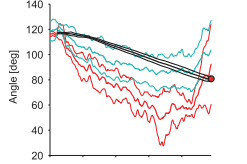Objective. Brain–machine interface (BMI) technologies have succeeded in controlling robotic exoskeletons, enabling some paralyzed people to control their own arms and hands. We have developed an exoskeleton asynchronously controlled by EEG signals. In this study, to enable real-time control of the exoskeleton for paresis, we developed a hybrid system with EEG and EMG signals, and the EMG signals were used to estimate its joint angles. Approach. Eleven able-bodied subjects and two patients with upper cervical spinal cord injuries (SCIs) performed hand and arm movements, and the angles of the metacarpophalangeal (MP) joint of the index finger, wrist, and elbow were estimated from EMG signals using a formula that we derived to calculate joint angles from EMG signals, based on a musculoskeletal model. The formula was exploited to control the elbow of the exoskeleton after automatic adjustments. Four able-bodied subjects and a patient with upper cervical SCI wore an exoskeleton controlled using EMG signals and were required to perform hand and arm movements to carry and release a ball. Main results. Estimated angles of the MP joints of index fingers, wrists, and elbows were correlated well with the measured angles in 11 able-bodied subjects (correlation coefficients were 0.81 ± 0.09, 0.85 ± 0.09, and 0.76 ± 0.13, respectively) and the patients (e.g. 0.91 ± 0.01 in the elbow of a patient). Four able-bodied subjects successfully positioned their arms to adequate angles by extending their elbows and a joint of the exoskeleton, with root-mean-square errors <6°. An upper cervical SCI patient, empowered by the exoskeleton, successfully carried a ball to a goal in all 10 trials. Significance. A BMI-based exoskeleton for paralyzed arms and hands using real-time control was realized by designing a new method to estimate joint angles based on EMG signals, and these may be useful for practical rehabilitation and the support of daily actions.
Presented on 04.03.2020 by Stephan Lehmler
Paper:
https://iopscience.iop.org/article/10.1088/1741-2552/aa525f/pdf

